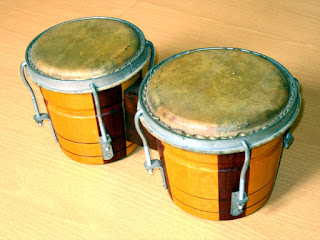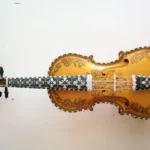
Bongo drums are a type of percussion instrument that is thought to have originated in both African and Cuban cultures. Bongo drums are two drums that are connected and played together. The larger drum is known as the hembra (female) in Spanish, and it is connected to the smaller drum, known as the macho (male) in Spanish. The general idea is that the bongo drums are Cuban in origin but African in concept due to design influences. Bongo drumming appears to have gained popularity in the late 1800s in Cuba in the Son and Changui music styles.
Interesting facts about Dongo Drums:
The bongo drums are thought to have originated in the late 1800s in Cuba’s eastern region, in the Oriente Province. The bongo drum made its way to Cuba’s western region, Havana, in the 1900s, with Son style music.
Bongo drums have an open bottom, similar to Bantu or Congo drums from central Africa, and are thought to have been influenced by African drum design.
Bongo drum heads vary in size but are typically between 6 and 7 inches and 7 and 8.5 inches.
Bongo drum heads for children are typically 5 to 6 inches in diameter.
The drummer usually holds the bongos between their legs when playing them. The position of the bongos is determined by the player, but the technique of striking the bongos is the same: the drummer strikes with their finger pads, thumbs, and heels of the hand, never their knuckles.
Drum oils are required to keep the skin of the bongo from drying out and cracking. This cracking can occur as a result of air drying out the skin and hands absorbing the oils, robbing the drum skin of moisture.
The majority of bongos are made of wood, with drum skins made of animal skin or plastic. Instead of wood, the body is sometimes made of ceramic or metal.
Bongos are sometimes mounted on a stand and struck with drum sticks rather than hands.
The drum skin, shell, lugs, tuning ring, bearing edge, and center block or bridge are all components of the bongo drum.
Tuning bongo drum skins was traditionally done with heat, but in the 1940s, tuning lugs were added to the bongo design, allowing the instrument to be tuned without the use of heat.
Because of the popularity of Cuban big band music, which gained international attention when it was introduced, bongo drums have become the world’s most common hand drum.
Bongoseros are musicians who play the bongo drums.
Augustin Gutierrez, Antolin Suarez, Pedro Mena, Jose Manuel Carriera Incharte, Romanocito Castro, Armando Peraza, Chino Pozo, and Ralph Marzan, among many others, are famous bongoseros who helped bring the bongos to international attention.
Both James Dean and Marlon Brando, Hollywood legends, learned to play the bongos from master bongosero and teacher Jack Costanzo.
Bongo Drum FAQs: A Deep Dive into the Rhythmic Duo
The bongo drums, with their infectious sound and rich history, have captured the hearts of musicians worldwide. Here’s a breakdown of some frequently asked questions:
Origins and Anatomy
-
Where do bongo drums come from? Bongo drums originated in Cuba, with roots tracing back to the Abakuá secret societies. They are a staple instrument in Afro-Cuban music genres like rumba, son montuno, and salsa.
-
What are the parts of a bongo drum? A bongo set consists of two small, open-bottomed drums of different sizes joined together by a wooden yoke. The larger drum, called the hembra (female in Spanish), produces lower tones, while the smaller macho (male) drum has a higher pitch. The drumhead, traditionally made from animal skin (cow, goat, or water buffalo), is stretched over the wooden shell and secured with tuning lugs or traditional rawhide ties.
-
What materials are used to make bongos? Traditionally, bongo shells are crafted from hardwood like oak or mahogany. However, some modern bongos are made from fiberglass or even metal for durability or affordability. Animal skin heads are still preferred for their rich sound, but synthetic heads offer weather resistance and easier tuning.
Playing the Bongos
-
How do you hold bongos? Bongos are typically played while sitting with the larger hembra drum positioned closer to the dominant hand. The drums rest between the knees or on a specially designed stand for added comfort and playing freedom.
-
How are bongos played? Bongos are played with the bare hands, using a combination of open hand slaps, finger strikes, and heel of the palm mutes to create a variety of tones and rhythms. The technique involves striking different areas of the drumhead to produce different sounds.
-
What kind of music are bongos used in? Beyond their Afro-Cuban roots, bongos have found their way into various musical genres. They are commonly used in Latin music styles like salsa, merengue, and cumbia. Additionally, their versatility allows them to add rhythmic flair to pop, rock, and even jazz music.
-
Are bongos difficult to learn? Bongos have a relatively simple design and basic playing techniques. However, mastering the art of producing a rich and dynamic sound takes practice and dedication. There are many resources available online and through music teachers to help beginners get started.
Buying and Maintaining Bongos
-
What factors should I consider when buying bongos? When choosing bongos, consider the size, material (wood and head), tuning system, and of course, budget. For beginners, a smaller, more affordable set with synthetic heads might be ideal. As skills develop, musicians can invest in higher quality drums with natural skin heads for a richer sound.
-
How do I take care of my bongos? Proper care extends the life and maintains the sound quality of your bongos. Keep them away from extreme temperatures and humidity, as this can affect the tuning and integrity of the drumheads. After playing, wipe the heads with a soft cloth to remove moisture and prevent build-up. Tuning regularly is crucial to maintain the desired pitch.
-
Where can I buy bongos? Bongos can be purchased from music stores, online retailers specializing in percussion instruments, or even some second-hand shops.
These FAQs provide a solid foundation for understanding bongo drums. Whether you’re a curious music enthusiast or an aspiring bongosero (bongo player), there’s a world of rhythm and tradition waiting to be explored!









